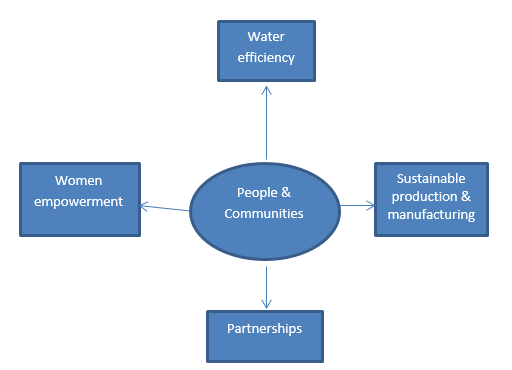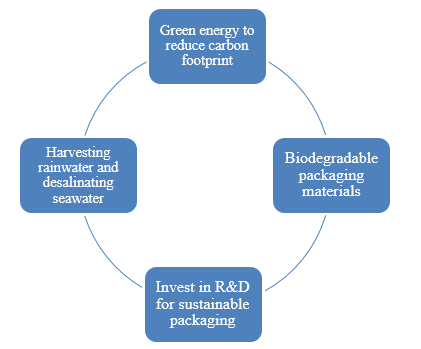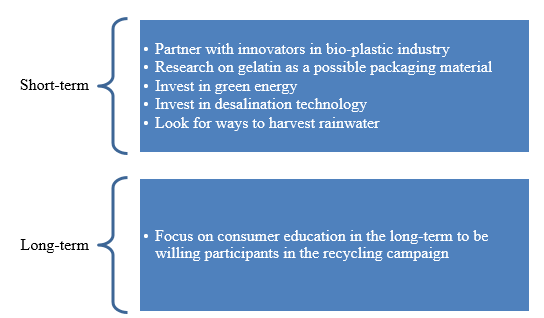Introduction
As part of the sustainable development goals (SDGs) of 2015, which seek to protect the planet, end poverty, and ensure peace, organisations are expected to incorporate sustainability in their operations. Specifically, companies engage in activities that affect the environment in different ways, thus they should focus adopting sustainable practices geared towards conservation. This paper discusses the concept of sustainable practices in the Coca Cola Company as a multinational organisation operating in different parts of the globe. The paper will identify key areas and goals of Coca Cola’s corporate sustainability strategy and examine the level of integration of the SDGs.
Company Overview
The Coca Cola Company is a multinational manufacturer, marketer, and retailer of non-alcoholic beverages with a market capitalisation of $202.1 billion as of December 31, 2018 (Coca Cola Company, 2020). With the global headquarters at Atlanta, Georgia, the company has over 500 beverage brands sold in over 200 countries and territories spread around the world. The company’s scope of operation is limited to carbonated soft drinks, fruit juices, energy drinks, sports drinks, coffee and tea-based products, and dairy-based drinks. These products are grouped into two main groups – beverage syrups and concentrates and finished beverages.
The company has approximately 225 bottling partners worldwide, and its products account for over 1.9 billion servings a day (Coca Cola Company, 2020). The company has been enjoying sustained economic growth, and as of February 2019, it had experienced 57 years of a consecutive annual increase in dividends paid to shareholders.
In 2018, shareowners collectively earned a total of $7.1 billion in dividends and net share purchases. The net operating revenues in 2018 stood at $31.3 billion, and in 2019, net revenues grew by 9 per cent, while organic revenue grew by 6 per cent during the same period (Coca Cola Company, 2020). The company has employed different strategies to ensure sustained year-by-year economic growth. First, it has leveraged its strong brand and new product innovations to stay ahead of the competition. Second, it has focused on mergers and acquisitions, especially involving brands in on-trend categories.
One such strategic acquisition is that of Fairlife, LLC, which is a value-added dairy business. Therefore, strategic acquisitions improve the company’s brand portfolio and positioning, which give it an edge in the highly competitive beverage industry.
In terms of social and environmental impacts related to Coca Cola’s operations, there has been mixed outcomes, both positively and negatively. The beverage industry relies heavily on water, and given that Coca Cola products are manufactured locally, different markets in the country or region of operation, local water resources are affected negatively. For instance, in 2016, the company had to close a bottling plant in India after activists raised concerns that its operations were depleting groundwater resources, thus threatening the sustainability of agricultural activities in the region (Rana, 2016). In addition, the company’s operations increase the global carbon footprint significantly through the emission of greenhouse gases in its various manufacturing plants.
Approximately 3 million gallons of gasoline are used annually to produce plastic bottles for the company (Hess, 2020), and the extensive use of fossil fuels contributes excessively to global warming and climate change. The Coca Cola Company also contributes to extensive land and water pollution through plastic bottles that it uses for packaging its products, hence environmental pollution.
However, despite the negative environmental impacts of the company’s operations, several positive social benefits can be identified. First, the company provides employment to millions of people around the world, and it supports the economic growth of countries through taxation. In addition, the company has partnered with the Global Fund and other related initiatives to achieve universal health in line with the SDGs.
For instance, by 2030, Coca Cola seeks to reduce premature deaths from communicable diseases by 33 per cent by rolling out and supporting elaborate prevention and treatment programs (Business for 2030, n.d.). The company has also committed to promoting the full participation of women in entrepreneurship and leadership by supporting close to 5 million women through its 5by20 initiative (Business for 2030, n.d). Therefore, the company has both positive and negative impacts on social and environmental aspects.
SDG Assessment
Corporate Sustainability Strategy: Key Areas and Goals
Since 2015 when the United Nations General Assembly launched the SDGs, Coca Cola has been reviewing and restructuring its operations to be in line with the specific goals of this initiative. The company champions SDGs as part of collective action needed to address the current and future problems that humanity faces or will face. The company is specifically focused on six SDGs goals including, “gender equity (SDG 5), clean water and sanitation (SDG 6), decent work and economic growth (SDG 8), responsible consumption and production (SDG 12), life below water (SDG 14), and partnerships for the goals (SDG 17)” (Coca Cola EU Dialogue, 2018, para. 3).
The company’s sustainability goals are detailed with specific objectives that should be achieved within certain timelines. The goals are measurable as they are designed around the SMART model, which requires specific, measurable, achievable, realistic, and time-bound goals. Every goal has a period within which it should be achieved. For instance, concerning SDG 12 on sustainable production, the company seeks to achieve 100 per cent recyclable packaging by 2025. This goal is measurable, realistic, and achievable as the company has embarked on research and development to that it meets its target within the set timeframe.
Table 1: Coca Cola’s SDGs of focus.
The Integration of the SDGs within the Corporate Sustainability Strategy
SDG 6, which deals with clean water and sanitation, is covered in the company’s water stewardship portfolio. As part of its strategy, Coca Cola has achieved the objective of returning 100 per cent of the water it uses in making its beverages. In 2018, the company’s goal was, “By 2020, improve water efficiency in manufacturing operations by 25 per cent compared with a 2010 baseline” (Coca Cola, 2018a, para. 1). This goal has been achieved and surpassed. For instance, in 2017, water efficiency in its manufacturing plants improved by 2.5 per cent from 15 per cent in 2016. For the last 15 consecutive years, the company has been recording improved water efficiency in its operations (Whelan & Fink, 2016).
These goals have been achieved through different strategies with specific focus on eliminating water from the manufacturing process. The company has invested heavily in novel technologies and innovations to improve its water efficiency. In addition, apart from reducing its water usage, Coca Cola seeks to ensure sustainable agriculture practices, such as recycling water used in its operations and treating it before being released into the ecosystem to support aquatic life. Similarly, through its Replenish Africa Initiative (RAIN), Coca Cola is targeting to ensure that by the end of 2020, at least 6 million people in Africa can access safe water for consumption.
On gender equity (SDG 5), the company launched its 5by20 initiative to empower over 5 million women in leadership and entrepreneurship areas. The company employed the Golden Triangle of business to engage governments and civil societies to achieve this goal (Banks, 2016). In 2018, 865,787 women in 92 countries had benefited from this program the company is on course to achieve its 5 million target (Business for 2030, n.d). 5by20 initiative operates on a simple model where women are helped to navigate the complicated business environment. For instance, women are given the training to gain the requisite skills that are needed to run a successful business (Mupavayenda, 2017).
After the training phase, these upcoming businesspersons are helped to access finance for their businesses. However, training and finance alone are not enough to ensure success in the marketplace. Therefore, Coca Cola goes the extra mile to link these entrepreneurs with other women in business through peer networks (Perez, 2015). However, inasmuch as the 5by20 initiative supports women, it plays a central role in the success of the company.
The women empowered through this program are in the company’s value chain, and thus it also benefits from having trained and experienced people to supply the needed raw material, distribute, and sell its products. If the company did not have this strategy, it could have suffered significantly in the marketplace for a lack of value in its supply chain.
On SDGs 12 and 14, Coca Cola launched its “world without waste” campaign in 2018. The goal was to “To help collect and recycle a bottle or a can for each one we sell by 2030” (Quincey, 2018, para. 3). Another goal was to achieve fully recyclable packaging by 2025 and by 2030, to be in a position to use 50 per cent of the recycled materials in the manufacture of its packaging materials. The company has invested in research and development to come up with a design for packaging and facilitate the achievement of this goal.
For instance, in 2018, the company joined DEMETO’s who pride in the development of the gr3n technology, which enables firms to recover PET plastic without the material being degraded in any way (Coca Cola Company, 2018b). Using this technology, the company has launched some products in 100 per cent recyclable materials, such as Ciel, which is a water brand in Mexico packed in rPET (100 per cent recyclable plastic material) (Coca Cola Company, 2018b).
Similarly, in Australia, the Mount Franklin water brand is currently available in rPET packaging material. The company has also made notable steps in its goal to collect one bottle or can for recycling for every one sold by 2030. The realisation of these goals will play a significant role in the achievement of the SDGs and promoting Coca Cola as a sustainability-conscious brand (Iivonen, 2018). Without the implementation of this goal, the company’s brand would suffer greatly, especially during contemporary times, where environment-conscious consumers are increasing.
In line with SDG 17, whereby the drivers of SDGs are called upon to form partnerships, Coca Cola has made significant steps to ensure that it joins hands with other like-minded organisations. The company has set up the New World program whereby the Coca Cola Foundation has partnered with Global Water Challenge, which is geared towards the creation of innovative and inclusive solutions in line with the SDGs. Coca Cola Company acknowledges the need for partnership to drive the global agenda on sustainability business practices. Therefore, through this partnership, the company has managed to fast track its objectives of ensuring that its operations are aligned with the SDGs.
In Lebanon, the company has partnered with the G Foundation to create the so-called water-wise villages, specifically in Menjez village, which has been facing acute water shortages due to the effects of climate change (Global Water Challenge, n.d.). In Turkey, through the Queen Bee Project, Coca Cola is facilitating the provision of beehives to 20 women as part of its efforts to improve the income levels among women entrepreneurs (Global Water Challenge, n.d.). If the company had not adopted the approach of partnering with like-minded organisations, it would not have achieved most of its SDG goals.
The implications of integrating SDGs in its corporate sustainability and strategic plans are evident given the company’s market position in the beverage industry. As mentioned earlier, consumers are becoming environment-conscious, and they want to associate with brands that source materials and produce goods sustainably (Mohd Suki & Mohd Suki, 2015). Therefore, given that Coca Cola Company has made notable steps to ensure sustainability in its business practices, customers are likely to continue associating with the brand. In addition, becoming part of the global society that is championing the realisation of SDGs by 2030, the company stands out as a socially responsible entity, which is not solely focused on its bottom line.

SDG Strategic Priorities
The Coca Cola Company has an elaborate sustainability strategy that seems to cover all areas of its operations. However, there is always room for improvement with the ever-changing economic and environmental dynamics in international markets. The future SDG strategic priorities should focus on three major areas based on packaging and manufacturing. First, the company should invest heavily in research and development to address the sustainable packaging problem. The current approach of using rPET plastic, which allows the recycling of bottles and cans without causing damage to them, is recommendable, but it faces a major challenge.
As consumer tastes change, people like to enjoy Coca Cola products on the go, which has contributed largely to the current problem where plastic bottles are littered all over the world, on land and in oceans. The problem with the rPET approach is that consumers may not be willing to recycle on their own, thus dumpsites and landfills would be filled with these reusable bottles. Therefore, the focus should shift to using biodegradable materials in the manufacture of bottles and cans. This way, even if the packaging materials are not reused, they will decompose naturally and prevent pollution in the long term. This innovation will lead to the development of new products, thus promoting the company’s competitive advantage.
Second, the company still relies heavily on non-renewable energy to run its manufacturing plants; thus, its carbon footprint is still high. Therefore, it should invest in research and development to improve its usage of green energy as a way of boosting its sustainability efforts. Renewable energy is cheaper as compared to fossil fuels, and this aspect could bring down its operational costs, hence profitability. Third, the company should address the water problem issue.
Underground water abstraction is a major problem in many parts of the world because it is unsustainable in the long-term. Therefore, Coca Cola should innovate on ways to use desalinated seawater where possible or create a mechanism to harvest rainwater for usage in its operations. These proposals create an avenue for the company to remain competitive in the market while promoting its sustainability agenda through the implementation of various SDGs.

Recommendations
In the short-term, the company should start by identifying the appropriate firms that could be acquired or merged with to create biodegradable packaging may materials for soft drinks. According to Cooper (2013), innovators have made promising steps in the field of bioplastics, and the company should focus on these discoveries. Gelatin has also been touted as a possible raw material that could be used in the manufacture of biodegradable packaging materials for beverages (Hanani et al., 2014). Therefore, the company should invest in technology and partner with the appropriate firms to achieve this goal of biodegradable packaging.
Additionally, Coca Cola should invest in R&D to innovate ways to power its energy needs using renewable energy and ways to harvest rainwater and desalinate seawater in large scale. In the long-term, the company should keep strategize on ways to educate consumers to be willing to participate in recycling the biodegradable bottles and cans. The ultimate goal is to recycle, reuse, and reduce of packaging materials irrespective of the materials used. Therefore, for the company to realise its sustainability goals, it needs the collaboration of consumers through their willingness to participate in the campaign to reuse bottles and cans.

References
Banks, H. (2016). The business of peace: Coca-Cola’s contribution to stability, growth, and optimism. Business Horizons, 59(5), 455-461.
Business for 2030. (n.d.). The Coca Cola Company. Web.
Coca Cola Company. (2018a). Improving our water efficiency: Meeting goals and moving goalposts. Web.
Coca Cola Company. (2018b). Progress against a world without waste: Holding ourselves accountable. Web.
Coca Cola Company. (2020). Coca-Cola reports strong growth in fourth quarter and full year 2019: Company achieves or exceeds all full year guidance. Web.
Coca Cola EU Dialogue. (2018). Meeting the SDGs: The greatest global change happens together. Web.
Cooper, T. A. (2013). Developments in bioplastic materials for packaging food, beverages and other fast-moving consumer goods. In N. Farmer (Ed.), Trends in packaging of food, beverages and other fast-moving consumer goods (FMCG) (pp. 108-152). Woodhead Publishing.
Global Water Challenge. (N.d.). Inclusive sustainable human development initiatives: New World. Web.
Hanani, Z. N., Roos, Y. H., & Kerry, J. P. (2014). Use and application of gelatin as potential biodegradable packaging materials for food products. International Journal of Biological Macromolecules, 71, 94-102.
Iivonen, K. (2018). Defensive Responses to Strategic Sustainability Paradoxes: Have Your Coke and Drink It Too!. Journal of Business Ethics, 148(2), 309-327.
Mohd Suki, N., & Mohd Suki, N. (2015). Consumption values and consumer environmental concern regarding green products. International Journal of Sustainable Development & World Ecology, 22(3), 269-278.
Mupavayenda, M. (2017). Women’s empowerment: A discourse analysis of the Coca-Cola 5by20 global initiative. Web.
Perez, B. (2015). The power of sustainability to create shared value: Coca-Cola demonstrates that doing good is good for business. Journal of Brand Strategy, 3(4), 310-315.
Quincey, J. (2018). Grading our progress towards a world without waste. Web.
Rana, P. (2016). Coca Cola closes plant in India. The Wall Street Journal. Web.
Whelan, T., & Fink, C. (2016). The comprehensive business case for sustainability. Harvard Business Review, 21, 1-12.
